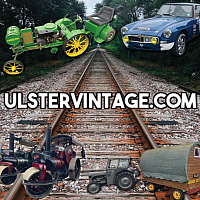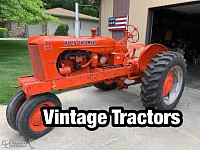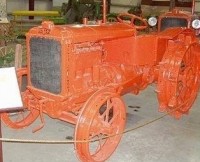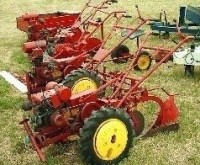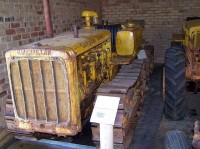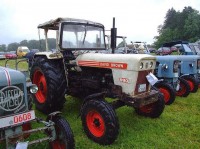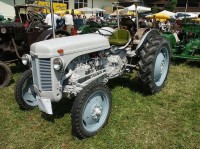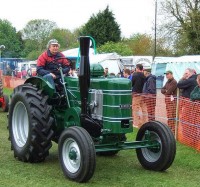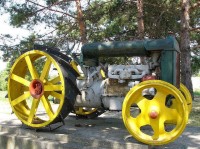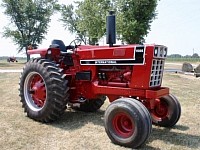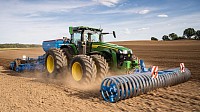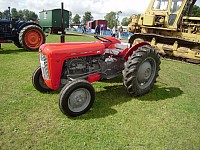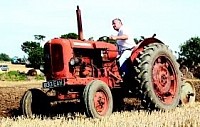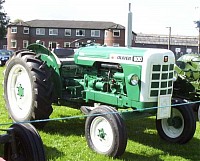Vintage Tractors
Vintage Tractors
Vintage Tractors
Here we provide Vintage Tractors and articles and videos of the each Vintage Tractors on this page just play the video you want in video playlist below you can choose what video by clicking top right corner and choose what video you want.
Allis Chalmers Tractor
Allis Chalmers Tractor
Allis Chalmers history can be traced back to 1847, but the company proper was formed in 1912 and based in Milwaukee, Wisconsin. It's first tractor was built in 1914, being a tricycle 10-12 model, that is, 10hp at the draw-bar and 12hp at the flywheel.
This model continued in production until 1921, selling approximately 2700 units through mail-order as the company had no established dealer network. The range developed into the more powerful 10-18, some of which were exported to France and sold under
the Globe brand, and later the 18-30.
In the 1920s many mergers and acquisitions took place and both Monarch and Advance-Rumely became part of Allis-Chalmers. In 1929, as many as 32 different companies formed the United Tractor & Equipment conglomerate, including Allis Chalmers, but this
soon collapsed and Allis-Chalmers managed to survive. The United Model U and E became the basis of the Allis Chalmers range, the former running until 1953, and it was at this stage the Persian Orange colour scheme was introduced to differentiate its products
from competitors offerings.
In the late 1930s, Allis Chalmers introduced its Model A & B tractors. The former replaced the model E in 1936 and ran until 1942, and the B, possibly the best known in the range, ran for 20 years between 1937-57. This initially had a bow-shaped front
axle, but when the tractor was supplied to Britain during W.W.II under the Lend-Lease scheme, a straight front axle was introduced to save costs. After the war, The Model B was manufactured in Southampton and later production was moved to Essendine in
Lincolnshire. Also at about this time, pneumatic tyres were introduced as an option on most models.
In the immediate post-war years, the Model G and WD were introduced, and in 1955 they launched their first diesel wheeled tractor, all other previous being either petrol or petrol/paraffin types, although diesel-engined Monarch crawlers had been made
since the late 1920s. In Britain, the D270 went into production at Essendine, to be replaced by the D272 in 1959, plus the ED40 in 1960. From 1955 onwards, there was a comprehensive range of D-range models manufactured in the States with up to 50 different
variations.
In 1960, the company changed the colour of its tractors to Persian Orange No.2 which was contrasted with cream wheel & radiator grill. Production carried on until the mid-1980s when the German Deutz company took over, renaming the tractor division
Deutz-Allis. However, this was short-lived, as in 1990 the company was acquired by an American holding company, with production of tractors in Wisconsin having ceased in December 1985.
Barford Tractor
Barford (Agricultural) Limited made a range of small lightweight garden tractors at their works at Belton near Grantham, Lincs. in the post-war years. Their original Barford Atom machine was introduced in the late 1940s and came in two versions, the "single"
or 2-wheel" version. It had a 11/4hp Villiers engine with a meagre fuel consumption of 1 gallon every 8 hours. Power was transmitted through a reduction gear and chain drive to the wheels. The "single" in effect had two pneumatic-tyred wheels side-by-side
underneath the engine and cost £62 10s in 1950, whereas the conventional two-wheel model cost £69 10s.
The Barford Atom model 15 replaced the original model in 1951. It had a 11/2hp Villiers engine with V-belt drive to an enclosed reduction gearbox and had two forward gears giving 11/2mph or 3mph. It was advertised as the "All The Year Round One Machine, 20 Different Jobs", and cost £84 10s in 1952, excluding attachments. Attachments were available for hedge trimming, grass cutting, hay sweeping, potato lifting, disc harrowing, drag harrowing, seed sowing, spraying, ploughing, hoeing, ridging, cultivating, log sawing, earth dumping, trailer towing, snow ploughing, water pumping, fertilizer spreading, rotorvating and plant pot washing.
The 1959 Chelsea Flower Show provided the horticultural public with the launch of the Barford Atom model 30. There were two engine options here, either a 3hp Villiers Mk15 or a 41/2hp Clinton. Again power was transmitted via a V-belt drive to a two-speed gear system with a lever-operated jockey pulley to engage drive to the wheels and the rotorvator attachment.
Two-wheeled tractors were often used with a trailer to move materials around, and Barford were no exception in offering a 71/2cwt trailer with internal expanding brake shoes. A wooden platform seat was provided for the driver and both sides and rear tailboard could be removed for easy loading. In addition, a steel sided 5cwt tipping dump truck with its own parking brake was also manufactured for the Atom range.
Oscillating cutter bar attachments, commonly called finger bar mowers, were offered in 3 sizes for the Atom. Described in a 1950 catalogue as "an invaluable accessory for private gardens, nurseries and estates", a 3ft bar cost £17 10s but was also available in 18" or 2ft widths. These were centrally mounted on the front of the tractor with an independent clutch to engage the drive. Barford also entered the lawnmower market in the 1960s offering a rotary mower called the Rotomo. This cost £30 and had a 98cc two-stroke engine, which was claimed to have ample power for the 18" rotary cutter.
Caterpillar Tractor
The Caterpillar brand evolved from the Holt and Best makes of track-laying tractors. Benjamin Holt produced his first steam-powered "crawler" in 1904, and produced further petrol-engined models in 1906-8. By 1915, Holt tractors were being used by the
Allies in W.W.I. In the years after the war, Daniel Best continued development of crawlers, culminating in his 1921 Best 30 Tracklayer, with an enclosed cab and bulldozer blade.
At this time, there was a considerable amount of litigation on-going concerning track-layer patents and two names kept cropping up, Holt & Best. Holt held a patent which enabled him to charge a licence fee to other crawler manufacturers, including Monarch and Cletrac. Most of Holt's production was for the military while Best supplied the agricultural market. In 1925, the two companies merged to form the Caterpillar Tractor Company. Holt had in actual fact bought out Daniel Best in 1908, but then had to compete with his son, Leo Best!
The first new model, the Caterpillar Twenty, went into production in 1927 and ran until 1933. In 1955, the Model 15 was introduced, which with the original 60, 30 and Two Ton, took its range to five. In 1931, the new Model 65 rolled off the production line in Illinois and this year also saw the change from the previous grey colour to the new Highway Yellow livery, seen as a means of brightening up the great Depression, and also for visibility on road construction projects. This has since become a standard colour for lots of construction equipment, not just Caterpillar products.
New diesel-engined variants, using Rudolph Diesel's initials, the RD8, RD7 & RD6 models went into production in 1935, followed by the RD4 in 1936. In 1938, the smallest crawler in the range was introduced, the D2 being suitable for 3 or 4-furrow ploughs. Larger models followed, with the D7 and D8 being used on the huge farms of the mid-West. By the late 1940s, the US Forestry Service were using machines such as the Cletrac Forty crawler with an after-market blade fitted to the front, and this coupled with W.W.II, marked a change of emphasis from agriculture to construction in the post-war years.
World-wide expansion followed with Caterpillar GB set up in 1950 and a joint venture with Mitsubishi in Japan in 1963. However, global recession in the 1980s cost Caterpillar dear and towards the end of that decade, production diversified and moved back towards agriculture. Product development continued with the advent of the rubber-tracked Challenger range in the 1990s, and Caterpillar acquired Peterborough based Perkins engines in 1997, a name synonymous with many manufacturers of tractors.
David Brown tractor
David Brown tractors really came about as a result of Harry Ferguson's involvement with the Huddersfield company in the 1930s. At the time they specialised in gear manufacture, and initially made gearboxes and later complete tractors for Ferguson using
Coventry Climax engines. Production ceased in 1939 because Ferguson wanted to cut costs and increase power, and was talking to Henry Ford as regards manufacture.
David Brown then started to manufacture a tractor of its own design with a hydraulic lift, the VAK-1. This was reintroduced in an improved form after the war, and in 1947 the Cropmaster was introduced, with a diesel-engined variant in 1949. These tractors are famous for their twin-seats, just large enough for a farmer and his dog, and their upswept cowling in front of the steering-wheel, designed to keep the cold air from the driver's hands. Industrial, forestry and tow-tug variants such as the Taskmaster were also produced, very often with winches and extra ballast.
The 2D model was introduced at the Smithfield Show in 1955. With the engine behind the driver, and with an underslung toolbar or reversible ploughs, it was designed for row-crop work where the operator could see exactly what he was doing without having to turn round. Only 2000 were made during a 6-year production run but this accounted for a large proportion of the market it was aimed at. Other similar machines were made by Allis Chalmers and Garner.
The basic design remained largely unaltered until 1956 when the 900 was introduced, but this was replaced by the 950 in 1958, with both diesel and petrol-engined variants, and in turn superseded by the 880 in 1962. In 1960 the smaller 850 was introduced and this in turn was replaced by the 770 in 1965. Throughout this period the basic livery was Hunting Pink with blue wheels and radiator on the 900, and yellow trim on the later 850 and 880 models.
David Brown also produced approximately 2000 tractors for export and sale to the Oliver Corporation in a green and white livery, manufactured in the 1960s. The David Brown company was taken over by Case in 1972 with the some of the existing range revamped and painted primarily in white, with municipal or industrial models usually in yellow. Factory-fitted cabs were introduced soon after. Gradually more powerful models were introduced such as the 995 and 1220. In later years, the livery changed again to Case red and the David Brown name was dropped in the late 1980s.
Ferguson Tractor
Harry Ferguson, born in Belfast in Northern Ireland, is perhaps the mot famous man ever to be associated with agricultural tractors and was responsible for the invention of 3-point linkage which revolutionised tractor design in the 1930s. His idea came
to be known as the Ferguson System. He originally commissioned David Brown to build tractors incorporating this feature and they were known as the Ferguson Brown. Only 1350 were made before Ferguson went to America to do a deal with Henry Ford.
This so-called handshake agreement led to the Ford Ferguson being produced in the early 1940s in America, but then Ford went on to produce the Ford 8N tractor which allegedly incorporated Ferguson's 3-point linkage ideas. This led to a split and substantial litigation but Ferguson couldn't compete with Ford in the courts and eventually accepted a pay-off, setting up his own factory in Detroit.
After W.W.II, this led to Ferguson doing to deal with the Standard Motor Company in England to produce his tractor which was very similar to the Ford 9N currently in production but with a more powerful engine and fourth gear ratio. Designated the TE20 (TE for Tractor England), the first tractors were produced in 1946, using an imported Continental petrol engine. Standard's own engine was substituted in 1947 and a diesel version was introduced in 1951, known as the TED20. Over 500,000 units were made in the period 1946-56, with a further 60,000 made in America between 1948-51.
The "Little Grey Fergie" became ubiquitous on British farms during the 1950s and the reason was the range of implements made available to complement the tractor. From straightforward attachments such as ploughs, cultivators, sub-soiler, etc, the range expanded to include drills, front-end loaders, fertiliser spreaders, trailers and even combine harvester conversions. Toady, no self-respecting British tractor collector would be without a Fergie, and many probably have one that has been in their family from new, such is their longevity.
Harry Ferguson sold his company to the Canadian agricultural company Massey Harris in 1953, receiving $16 million in shares in return, and the company was renamed Massey Harris Ferguson for a while. Subsequent development of the TE20 range saw the grey-gold variant in 1954, and it eventually evolved into the red-grey MF35 later in the decade.
Field Marshall Tractor
William Marshall at Gainsborough founded the firm of Marshalls in 1848. At first the firm manufactured mill gearing and traded as machinists. Soon they were making threshing machines and in 1856 the first portable steam engine was manufactured, as well
as boilers, some being supplied to Russia for the railways. At the same time, the manufacture of steam stationary engines of all types commenced.
In 1908, the first oil tractor was produced, but during 1914-18 Britannia works was given over to the War effort, so it was not until 1919 the company reverted to its previous product range. In 1930, the firm of Clayton & Shuttleworth was acquired; the first 15/30 diesel tractor was produced and was followed by the Model M in 1938. However, in 1939, the factory was again devoted to the war effort.
The form quickly reverted to normal conditions after the war and established itself as a leading tractor manufacturer with the Field Marshall single-cylinder series, introduced in 1945, many of which can still be seen today at vintage rallies in use for belt working. In 1946, the firm acquired John Fowler & Company (Leeds) Ltd and to mark its centenary in 1948, introduced the Marshall Fowler VF crawler.
The 70hp Marshall MP6 model was introduced in 1956, but only 200 were made and 190 of those exported, making it very rare today. 1956 also heralded the introduction of the Track Marshall crawler, which continued into the 1960s, alongside a range of Marshall diesel road-rollers. In 1968, Marshalls was absorbed into the Thos. W Ward Group and in 1969 all tractors were traded under the joint name of Marshall Fowler Ltd.
In 1974, a new tractor production plant was opened, and Wards sold their interest in the company to British Leyland who renamed the company Aveling Marshall Ltd. The main products were crawler tractors and wheeled shovel loaders at this time. In 1979 BL sold off their special products division and Aveling Marshall came into the ownership of local businessman, Mr Charles Nickerson. He continued to trade under the name Track Marshall Ltd.
In 1981 Mr Nickerson acquired the Leyland wheeled tractor business and carried on production of the blue range of Leyland tractors, and the company was renamed Marshalls Sons & Company Ltd in 1982. In 1984, Marshalls introduced the own range of 100 Series tractors in the familiar beige/yellow colour, which were based on the previous Leyland offerings.
Fordson Tractor
Already producing cars in the 1910s, Henry Ford looked to develop a two-plough tractor using some interchangeable components he could sell for $200. His aim was to do for farming what the Model T car had done for motoring. The ultimate result was the
Model F which entered production in 1917, but which was somewhat more expensive than predicted at $750! However, on the back of the Model T car's reputation, Ford sold the Model F in large numbers.
Seen as a means to help end W.W.I, the British Government asked Ford to manufacture in Britain, but after German bombers got ever-more daring and bombed London in daylight, factory space was given over to aeroplane production and Ford was left to manufacture in America. At this time another company set-up Ford Tractor Company using the name of one of their staff making a similar tractor to pre-empt his success, and this meant Henry Ford couldn't use the same name. However, he set up Henry Ford and Son, and shortened it to Fordson.
In 1922, Fordson tractors accounted for 70% of home tractor sales, but a price war with International Harvester cut sales, but by 1928 Fordson had partly regained its market share to 47%. In 1919, production had started in Cork, Ireland, marking the first time the same tractor was being produced in both America and Europe. These tractors were usually grey with red wheels. In 1929, production ceased in America with all production being done in Ireland, and in 1933, all production moved again to Dagenham, England, where ironically, tractors were exported back to the States.
The Model F was superseded by the Model N in the 1930s and like Allis Chalmers, the livery was changed to a bright orange colour. However, during W.W.II, tractors standing on the docks of the Thames were thought to be quite a target for German bombers and the colour was changed to a dark green. After the war, the colour changed again to a dark blue with orange wheels, and this livery was used on the Fordson Major (commonly referred to as the E27N) when it was introduced in the 1950s.
With the introduction of the New Fordson Major and Dexta in the 1960s, the livery changed yet again to a royal blue with grey contrasting wings etc. There are many variations on these liveries with some models such as the Super Major and Power Major having different coloured grills, etc. Alongside, all these British designed tractors, a completely different range of Ford tractors were being produced in America, initially using the grey/red livery, and nowadays, Ford New Holland are using a blue colour very similar to the tractors produced in the late 1970s.
International Tractor
International Harvester was formed in 1902 by the merger of McCormick and Deering, and the fledgling company initially sold just 2 tractors. The Type A was launched in 1906 in 12, 15 & 20hp sizes, followed by the Type B which was made until 1916.
Powered by paraffin, the 45hp Mogul 8-16 (marketed by McCormick in the USA) was launched in 1916 and the 22hp Titan 10-20 (marketed by Deering) in 1918. Both were sold in Britain quite successfully. More than 78,000 Titans were made until the Junior
10-20 followed in the 1920s, with the later 10-20 model being produced at least until 1939.
The Farmall name was introduced in 1924 with the Regular model. The range was updated in 1932, with the addition of F12, F20 and F30 models all being row-crop tractors with adjustable wheel-track, based on the Regular. Initially in the traditional grey, the livery was changed in 1936 to a bright red, which was to be the norm for the next four decades. The reason for this change was two-fold, firstly to make them more attractive to potential buyers, and secondly, to make them more visible on the roads with ever-increasing traffic levels. These tractors were still on steel wheels and the F14 replaced the F12 in the mid 30s. Tractors were also marketed under McCormick-Deering and International brands, the W-series being launched in the late 1930s. Their first crawler tractor was unveiled in 1928 and was known as the TracTracTor, being renamed as the T20 in 1931.
The Farmall range was modernised and expanded during the 1940s and 1950s and included models such as the Cub, A, C, BM, M, etc. They were updated in the early 1950s, being designated Super models. In the post-wars years, IH followed other manufacturers such as Allis Chalmers and Fordson in opening factories in Britain, with a plant at Doncaster. The Farmall Cub was also made in France with a rounded bonnet compared to the more angular American version. Electrics and PTOs were often optional extras in this period with many models still being equipped with belt-pulleys for driving machinery.
Models continued to be developed during the 60s and 70s with a distinctive International identity, with the red-and-white 414 and 584 models typical of British models. Some of the smaller horticultural models such as the Cub and Cub Cadet changed livery again in the 1960s to a smart yellow and white scheme, but as the company entered the 1980s, the economic crisis that loomed was to have far-reaching consequences. In 1982, losses amounted to $1.6 billion and in 1984 the company who controlled Case tractors took over to form Case IH.
John Deere Tractor
The history of the massive John Deere company dates back to 1837 when the 33-year old pioneer blacksmith from Vermont designed a self-polishing plough in his shop in Illinois. However, it was his son Charles who went on to expand the company started by
his father, producing a whole range of agricultural implements until his death in 1907. However, it wasn't until 1918 when the company acquired the Waterloo Gasoline Engine Company that tractors became part of their offering. This was the start of
the modern John Deere company.
The Waterloo Boy Model N tractor was kept on in production until 1924, slightly overlapping the introduction of the 2-eylinder Model D. many other manufacturers were offering 4-cylinder machines but JD's astute business sense saw that the post-war tractor boom was over and designed the 2-cylinder engine for ease and economy of maintenance. The basic design, albeit continually upgraded, remained in production until 1953 when about 160,000 units had been produced.
A range of row-crop tractors was introduced in 1928 and were known as the GeneralPurpose or GP models. The Model A was produced between 1934-1952 and was a tricycle design for row-crop work, with over 328,000 being made. The smaller Model B was produced between 1935-1952, including a crawler version during the 1940s. However, the basic range had changed little in the years up to 1937, with their "unstyled" tractors looking old-fashioned compared to the stylised offerings from other manufacturers. The Models A & B were restyled in 1937, followed by the D & H models in 1939, and the G in 1942. By this time, pneumatic tyres were being fitted as standard, although the rubber shortage in the later years of the war forced a return to steel wheels.
In the immediate post-war years, JD replaced the H, LA & L with the Model M in 1947. This was closely followed by the MC crawler & MT (tricycle) in 1949. Production of both models reached 70,000 before their demise in 1952. The first diesel-engined tractor, the Model R, was introduced in 1949, and was the last tractor to carry a letter name before the switch to numerical designations. This was the replacement for the D and continued until 1954.
The 20 Series was introduced in the mid 1950s, followed by the Series in 1958, plus the 40, 50, 60, 70 & 80 Series all followed during the 50s & 60s. The 50 & 60 Series replaced the B & A respectively in 1952 while the 80 Series replaced theModel R. In 1959, the first 4-wheel drive variant was introduced and the end of the 1950s saw John Deere expand world-wide with manufacturing bases in Mexico and Germany. To this day, the company has built a reputation based on "Nothing runs like a Deere".
Massey Ferguson Tractor
Massey Harris was formed in 1891 in Toronto, Canada, and really got into tractor manufacture in the late 1920s. One of the earliest four-wheel-drive tractors was the Massey Harris General Purpose of 1930, and the Model 25 was a popular model through the
30s & 40s, as was the 101. The Massey Harris Challenger of 1936 was the last design to carry over the Wallis tractor green livery before the Red & Straw-yellow scheme became standard in the mid 1930s.
After W.W.II, the Challenger evolved into the Model 44, and was later joined by the 11, 20, 30 & 55. The 30 featured a 5-speed transmission and more than 32,000 were made before the 1953 merger with Ferguson. The tractor built in the highest volumes prior to the merger was the Pony which proved popular in overseas markets, but not in its home North American market where it was considered too small for many applications. Canadian production ceased in 1954, but production carried on in France from 1951 including a Hanomag diesel-engined 820 variant from 1957. It was revised again in 1959, becoming the 821. Total production exceeded 121,000 units over a 10-year period with 90,000 being produced in France.
The post-war Model 44 had been a big success in America with 90,000 being produced. This model became the 744 when European production commenced in Manchester in 1948 and later moved to Kilmarnock, although this was mainly assembly of imported components. Approximately 17,000 were made plus another 11,000 of the Perkins diesel-engined 745 before production ceased in 1957. That year also marked the company's renaming as Massey Ferguson.
Up to this point, Massey Harris had neglected tractor development in favour of its combine harvesters, but the merger suddenly elevated its position in the market place. For a number of years, the two ranges ran side-by-side as both names had loyal followers. For instance, the Ferguson 35 was revamped and sold under different names in both ranges.
After 1957, a unified range was presented under the Massey Ferguson banner, using a red-&-grey livery, the first of which was the MF35. MF50, 65 & 75 models followed, and the MF35 was updated to the more angular MF135 in the early 1970s. Other models followed suit and gradually through the 70s and 80s tractors increased in size, as indeed did the parallel range of combines. MF carried on Harry Ferguson's legacy of implement design with a comprehensive range of equipment, including muck-spreaders and balers.
Nuffield Tractor
Nuffield tractors was formed by Mr William Morris, like Henry Ford, a man who initially made his name in the car market. From as early as 1926, he did quite a lot of research on firstly crawler and then wheeled tractors. By 1946, a dozen prototypes were
being tested in Lincolnshire and this resulted in the launch of the Nuffield Universal at the Smithfield Show in 1948. There were two versions, the M4 and the M3 each denoting the number of wheels. Both had 3-point linkage, drawbar and PTO as standard.
The engines were based on the wartime Morris Commercial units and were started on petrol and switched over to paraffin when warm. A Perkins diesel engine was added later and when Austin & Morris were to merge to form British Motor Corporation, a home-grown engine was used. The Universal 3 (3-cylinder) was added to the range in 1957 and the 4/60 (4-cylinder 60hp) came along in 1960. Both these models were face-lifted in 1964 to become the 10-42 and 10-60 models, and production was moved from Cowley to Scotland.
Smaller models were added to the range such as the petrol-engined Mini and the diesel 4-25 model. In 1967, following the merger of Austin-Morris, the models were renamed as BMC but before the public could adjust to the new name, BMC changed its name to British Leyland Motor Corporation and the livery changed from the bright Nuffield orange to the Leyland metallic blue. Production of Leyland tractors finished in the early 1980s with the sale of the business to the Nickerson organisation.
Oliver Tractor
The Oliver Chilled Plow Company had originally been founded in 1855 by a Scottish immigrant James Oliver who had patented a plough which gave long-life and toughness. Oliver Farm Equipment Sales Company was formed in 1929 from the merger of five different
companies, including Hart-Parr, who already produced tractors. Soon after the merger, work began on developing a range of tractors which were based on Oliver's own designs, Type A & B row-crop prototypes.
Oliver pioneered the use of laterally-adjustable rear wheel track to suit different crop spacing but other manufacturers were quick to latch on to this development and soon followed suit. Tractors were available in Standard, Western, Ricefield and Orchard versions and made until 1937. These models migrated into the Oliver Hart-Parr Models 70 & 90 in the late 1930s, and carried a pale-green livery with yellow trim & red wheels.
The Hart-Parr suffix was dropped in 1937 and the Model 80 was introduced in 1940, but this carried the older Hart-Parr influenced dark-green livery, and was indeed an old-fashioned tractor compared to the 90. A smaller model, the 60, was also introduced in 1940, and in 1944, Oliver acquired Cletrac, which itself had taken over Avery previously. One particular model in the Oliver range, the 90 with its modern streamlined looks and powerful smooth engine, sold well in excess of expectations and continued until 1952, when it became the 99.
In 1948, to celebrate 100 years of trading under the Oliver name, the company introduced the Fleetline range of 66, 77 & 88 models, which featured new grilles and tinwork. With a range of diesel, petrol & petrol/paraffin engines, plus PTO as standard, but alas no hydraulics, there was a solution for most applications within the range. The Super series of 44, 55, 66, 77, 88 & 99 followed during the 1950s, and carried a lighter green & white livery.
In 1960, Oliver was acquired by White Motor Corporation which also bought Cockshutt & Minneapolis-Moline soon after, and eventually merged to form White Farm Equipment. The Oliver Super range introduced in 1955 carried on into the early 1970s, eventually being fitted with angular-shaped cabs, more than a decade after White took over. Both companies were ultimately absorbed into AGCO.
